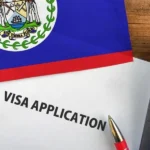
By, Gokite Tour
- 1.1k Views
- 6 Min Read
- (0) Comment
Different Types of Italy Travel Visas Explained
Italy, renowned for its rich history, breathtaking landscapes, and exquisite cuisine, stands as one of Europe’s most sought-after travel destinations. Whether you dream of wandering through the streets of Rome, marveling at the art in Florence, or relaxing along the Amalfi Coast, planning your visit begins with securing the right visa. Understanding the various Types of Italy Travel Visas is crucial, as each category caters to specific travel purposes, from short vacations to long-term stays.
Navigating the Italian visa system can initially seem complex, particularly if you’re unsure about the options available. Questions like how many visa types are there in the Italy or which Italy visa is easiest to get are common among first-time applicants. This comprehensive guide will help you unravel the different types of Italy travel visas, simplifying the process so you can confidently plan your Italian adventure.
1. Short-Stay Schengen Visa (Type C)
One of the most popular Types of Italy Travel Visas to Italy is the Short-Stay Schengen Visa, also known as Type C. This visa permits travelers to visit Italy and other Schengen Area countries for up to 90 days within a 180-day period. It is ideal for tourists, business visitors, and those attending cultural or sporting events.
Which Italy visa is easiest to get? Generally, the Type C visa is considered the simplest to obtain, provided that applicants have a clear purpose for travel and submit a well-prepared application. Essential documents include proof of accommodation, travel insurance, financial means, and a return ticket.
2. Tourist Visa
The Tourist Visa falls under the Short-Stay Schengen Visa category but is specifically intended for those visiting Italy for leisure and sightseeing. It allows for travel throughout the Schengen Zone and is valid for up to 90 days.
Many travelers wonder, which Italy visa is easiest to get for short vacations — the Tourist Visa is often the best option, as it requires minimal documentation compared to long-term permits. It typically involves providing a detailed itinerary, hotel bookings, and evidence of financial support.
3. Business Visa
Another common type of travel visa to Italy is the Business Visa, also a Short-Stay Schengen Visa (Type C). It suits individuals traveling to Italy for business-related purposes such as attending meetings, conferences, trade fairs, or negotiating contracts.
Applicants must provide invitation letters from Italian companies, proof of business relationships, and supporting documents outlining the nature of the trip. For business professionals, this visa streamlines the process of conducting short-term commercial activities in Italy.
4. Family/Friends Visit Visa
The Family/Friends Visit Visa is designed for individuals who plan to visit relatives or friends residing in Italy. This visa, categorized under the Short-Stay Schengen Visa, allows for a 90-day stay.
Applicants need to submit an invitation letter from their host in Italy, along with documents proving the relationship and accommodation arrangements. Understanding how many visa types are there in the Italy will help applicants determine that this visa specifically caters to personal visits rather than tourism or business.
5. Student Visa (Type D)
For those intending to study in Italy for more than 90 days, the Student Visa (Type D) is required. This long-term visa is suitable for university students, researchers, and participants in cultural exchange programs.
To apply, students must provide enrollment confirmation from an Italian educational institution, proof of financial means, health insurance, and accommodation details. Knowing the right type of travel visa to Italy ensures that students can focus on their academic journey without legal hurdles.
6. Work Visa (Type D)
The Work Visa (Type D) permits foreign nationals to engage in employment within Italy for an extended period. This visa requires sponsorship from an Italian employer and is contingent on the issuance of a work permit (Nulla Osta) by Italian immigration authorities.
Applicants must present an employment contract, work permit, and evidence of qualifications. If you are curious how many visa types are there in the Italy, this work visa is one of several long-stay permits tailored to professional engagements.
7. Family Reunification Visa
The Family Reunification Visa allows family members of legal residents or citizens of Italy to join their loved ones. It supports spouses, children, and dependent relatives who intend to live in Italy long-term.
Applicants must provide proof of relationship, accommodation, and financial support. Among the Types of Italy Travel Visas, this visa serves an essential role in maintaining family unity for residents and expats.
8. Elective Residence Visa
For retirees and individuals with sufficient independent means, the Elective Residence Visa offers the opportunity to live in Italy without employment. It is perfect for those looking to enjoy Italy’s lifestyle while financially self-sustaining.
This visa requires proof of substantial income or savings, valid accommodation, and health insurance. It is a niche but increasingly popular option among affluent individuals and retirees seeking a permanent move to Italy.
FAQs
Q1: How many visa types are there in the Italy?
There are multiple visa types for Italy, broadly categorized into Short-Stay Schengen Visas (Type C) and Long-Stay National Visas (Type D). These include Tourist, Business, Student, Work, Family Reunification, and Elective Residence visas, among others.
Q2: Which Italy visa is easiest to get?
The Short-Stay Tourist Visa is generally regarded as the easiest to obtain, provided applicants meet the basic requirements and have a clear travel purpose.
Q3: How long does it take to process an Italy visa?
Processing times vary but typically range from 15 to 30 calendar days, depending on the type of visa and the applicant’s nationality.
Q4: Can I extend my Italy visa?
Extensions are only possible under exceptional circumstances. Travelers are advised to apply for the correct visa duration initially.
Q5: Can I visit other Schengen countries with an Italy visa?
Yes, a Short-Stay Schengen Visa for Italy allows travel to all Schengen member countries within the permitted period.
Conclusion
Understanding the types of travel visa to Italy is crucial for ensuring a smooth and successful trip. Whether you plan to explore Italy’s artistic heritage, pursue educational opportunities, or reunite with family, selecting the correct visa type is the first step. Knowing how many visa types are there in the Italy helps you navigate the process more effectively, preventing unnecessary delays or rejections.
If you’re wondering which Italy visa is easiest to get, the Short-Stay Tourist Visa remains the most straightforward option for leisure travelers. However, with proper preparation and attention to detail, applicants can successfully secure the appropriate visa for any purpose. Embark on your Italian adventure with confidence, armed with the right information to make your journey unforgettable.
Most Popular International Visas for Omanis
Albania Visa | Argentina Visa | Australia Visa | Austria Visa | Azerbaijan visa | Bahamas Visa | Bahrain visa | Bangladesh visa | Bosnia Visa | Brazil Visa | Brunei Visa | Cambodia visa | Cameroon visa | Canada Visa | Chile visa | China Visa | Colombia Visa | Croatia Visa | Cyprus visa | Czech republic visa
How to Apply visa for other countries
Denmark visa | Egypt visa | Ethiopia Visa | France visa | Germany visa | Greece visa | Hong Kong Visa | Hungary visa | India visa | Indonesia Visa | Ireland visa | Italy Visa | Japan visa | Jordan visa | Kazakhstan visa | Kenya visa | Kuwait Visa | Madagascar visa | Malaysia visa | Malta Visa
Recommended Read: Complete Visa Information for Italy Travellers





Leave a comment:
You must be logged in to post a comment.